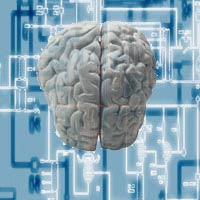Miguel Nicolelis continues his streak of cutting edge papers in neuroprosthetics. He finds that the monkey motor cortex rewires to reflect the presence of the robotic arm it has control of in his experiments. This is not suprising considering other people have shown previously that the motor cortex re-maps to reflect any tool that is used frequently, but it does very much strengthen the argument that the primate neocortex is for all intensive purposes "plug and play".
The news story follows:
Monkey brain rewires to use robotic arm
By STEVE MITCHELL
WASHINGTON, May 10 (UPI) -- The brains of monkeys who learned to control robotic arms rewired themselves to treat the arms as if they were real -- a finding scientists say has implications for developing limbs to assist handicapped humans.
The findings build upon a 2003 study that found monkeys were able to control robotic arms using only signals from their brains and without moving their own arms.
Miguel Nicolelis and colleagues at Duke University's Center for Neuroengineering analyzed the data to see what was happening to the primates' brain cells as they learned to use the robotic arm to position a cursor on a video screen.
"The monkey's brain incorporates properties of the robotic arm as if it was another arm and changes to adapt to those properties," Nicolelis, a neurobiologist, told United Press International. "Basically, the brain extends the representation of the animal's body and enhances the sense of self. The animal can function using two arms but also can function as if he has a third arm."
This not only expands the limit of the brain's ability to adapt itself to new situations, it also "opens new venues for how to design prosthetics that can be more readily incorporated by the brain," he said.
Such prosthetics, dubbed "neuroprosthetics" by Nicolelis, could give those needing artificial limbs the ability to control them as if they were the real thing.
Experiments in Nicolelis' lab already are building on the neuroprosthetic concept. His team is developing ways patients can receive feedback sensation, either visually or by touch, from neuroprosthetic devices via electrodes running from the limb to the brain. This would make the appendages function more like real limbs by providing a perceptual image in the patients' minds, he said.
Although neuroprosthetics probably are five years away at least, Nicolelis said, "It's becoming rapidly a new area of clinical research."
He also noted studies conducted last year in his own lab have shown this principle can work.
Research in other labs also has advanced this concept. In February, a team from the University of Pittsburgh School of Medicine reported a monkey fitted with a robotic arm controlled by only its brain signals was able to feed itself using the arm. Tiny electrodes implanted in the brain translated the brain signals into movement of the robotic arm.
In Nicolelis' study, which appears in the May 11 issue of the Journal of Neuroscience, the monkey's brain was able to adapt to the robotic arm by shifting some of its neurons that previously were used to control its own arms to become more attuned to the function of the robotic arm.
When the researchers analyzed the brain signals collected during the experiment, they found the monkey simultaneously carrying out an activity with its own arm while performing another with the robotic arm.
Jack Uellendahl, a clinical specialist in prosthetics at Hanger Prosthetics and Orthotics in Phoenix, Ariz., called the findings "fascinating" but believes the application to artificial limbs is a long way off.
The greater potential might be for quadriplegics rather than for amputees, said Uellendahl, who has more than 25 years of experience in the prosthetics field.
Recent advances in enabling amputees to control prostheses using their residual muscles already have allowed patients to exceed the dexterity of current artificial limbs and devices, such as hands, wrists, elbows and shoulders, he said. Rather than developing better ways to control prostheses, there might be a greater need to develop better prosthetic joints, he added.
Developing better control methods based on findings from the monkey research may have a spillover benefit.
"Perhaps this method of controlling the full variety of prosthetic joints possible will encourage more development of more sophisticated prosthetic joints," Uellendahl said.
The findings challenge some experts' views of the brain's plasticity, Nicolelis said. Although it has long been accepted the human brain is uniquely adaptable to functioning in novel situations and learning to use new tools, Nicolelis and his colleagues believe their results push the boundaries of that concept.
They propose the human brain has the unique ability to change its concept of self and this extends to the tools humans use. This is not too surprising since the brain routinely incorporates tools in everyday use into its perception of who people are.
"Everything from cars to clothing that we use in our lives becomes incorporated into our sense of self," Nicolelis said. "So, our species is capable of 'evolving' the perception of what we are."
Steve Mitchell is UPI's medical correspondent. E-mail sciencedesk@upi.com.


















































